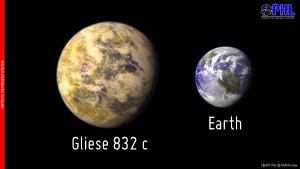Blog
The Red Zone
30 June 2014
 PHL @ UPR Arecibo
PHL @ UPR AreciboRecently there’s been news of the discovery of the closest potentially habitable exoplanet yet.1 Named Gliese 832 c, it is a “super-Earth” orbiting in the habitable zone of a red dwarf star. In April of this year, there was news of the “most Earth-like planet yet”. Named Kepler 186 f, it is a super-Earth orbiting a red dwarf star. In 2012, there was an announcement of the “most habitable exoplanet yet” named Gliese 581 g. It is a …wait for it… super-Earth orbiting a red dwarf. Whenever a new potentially habitable world is announced, it will likely be a super-Earth orbiting a red dwarf. But why?
It first has to do with the nature of stars. The majority of stars are red dwarfs. They make up about 3/4 of all main sequence stars, compared to only 8% that are Sun-like (G-class). From what we’ve seen, pretty much all stars have planets, so all things being even most planets in the universe orbit red dwarf stars. It is to be expected then that most potentially habitable planets are around red dwarfs.
It also has to do with the nature of planet hunting. There are two major ways to find a planet around another star. The first is known as the transit method, where a planet passes in front of its star, causing it to dim slightly. This dip in brightness is pretty small, which can make it difficult to observe. But the smaller the star and the larger the planet, the bigger the dip in brightness. So large planets around small stars are easier to find than smaller planets around larger stars. The second method is known as the radial velocity method. This technique measures the Doppler shift of a star as it wobbles toward and away from us. The wobble is due to the gravitational pull of a planet as it orbits the star. The bigger the planet the greater the pull, and the smaller the star the more it reacts to that pull, so larger planets around smaller stars produce more wobble than smaller planets around larger stars. So again it is easier to find the former than the latter.
Finally, it has to do with our definition of “potentially habitable”. In this case potentially habitable means the planet has to be within the right distance range for liquid water to be possible. In our own solar system that is about the range from Venus to Mars. It also requires that the planet must be rocky like Earth. This means a planet can’t be larger than about 2 Earth diameters, or a few Earth masses. Basically within the Mars to super-Earth range of size.
Of the planets that meet those conditions, super-Earths around red dwarfs are the easiest to find. So that’s why they are so often in the news. Of course none of this says anything about whether the planets actually have life. One big downside of red dwarfs is that they tend to produce large solar flares and x-rays that would be pretty hostile to life on a closely orbiting planet. Red dwarfs likely have the most potentially habitable planets, but they might not have the most actually inhabited planets.
We are still in the early days of planet discovery. What you’ll see over time is that new “potentially habitable” planets will be more Earth-like in size, and orbiting more Sun-like stars, until eventually we will find one very similar to our own.
Wittenmyer, Robert A., et al. “GJ 832c: a super-Earth in the habitable zone.” The Astrophysical Journal 791.2 (2014): 114. ↩︎